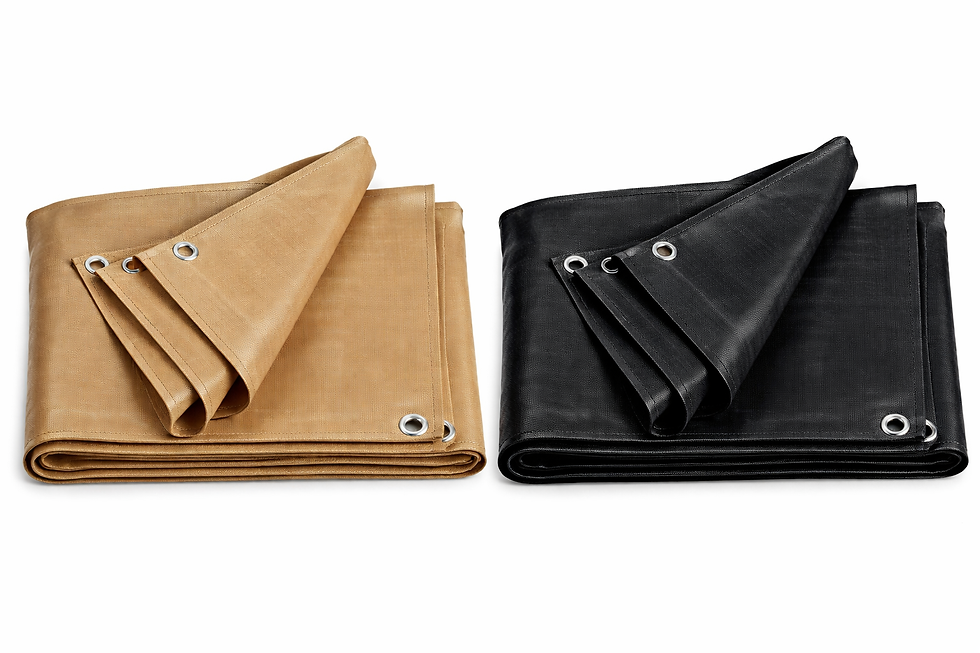How to Choose the Right Thickness for Your Waterproof Tarpaulin
- Bradley Tomlinson

- Oct 22, 2024
- 4 min read
Tarpaulins accessible for buy moreover have diverse thickness and the most common ones are the lean coverings for straightforward scope and the thick ones which are strong to provide assurance against climate components and additional dealing with. Hence, choosing a appropriate tarp thickness is significant as a lean Tarpaulin might effectively tear whereas an excessively thick tarp may be as well huge and overwhelming. Here are a few tips on selecting the appropriate tarp thickness for your specific needs:
Consider the Application
First, consider what you arrange to do with it and how you will be utilizing it to decide what sort of paper it is suitable to utilize. This will cruel recognizing whether the tarpaulin will be utilized for covering amble, hardware or vehicles. For crisis purposes like roof harms due to storm? Open air occasions require shield from climate conditions; hence? Or if it is for overwhelming utilization such as a development location where it is required for the specialists to cover themselves with the covering? It is up to you to select the thickness agreeing to your necessities for the particular product.
Clear plastic at 8-10 mil is perfect for common utilize such as ensuring plants or kindling, and covering furniture in the patio. For those vehicles and hardware, it is prescribed to buy 10-14 mil tarps that are not effortlessly punctured or tore. Such sorts of tarpaulins are idealize for withstanding intense open air climate conditions such as wind, rain, and sun presentation when the tarpaulin is utilized outside and the thickness of 18 mil and over is perfect for such conditions.
Factor in Outside Conditions
Think of the conditions the tarpaulin will be subjected to – will it be utilized in regions uncovered to coordinate daylight or does it have to be utilized in regions where it will be uncovered to as it were constrained daylight? Numerous individuals utilize this address in the taking after frame: Parcels of wind? Parts of rain? As a useful nourishment, is it for the long term or brief term utilize? Thicker tarps, which is 14-18 mils thicker can way better withstand the climate challenges such as UV beams, warm, wind, and rain. For occasion, if it will be utilized for the most part inside or for short-term employments, a 8-12 mil tarpaulin might be great enough.
Evaluate Quality Needs
First off, consider the toughness you require from the tarp. Will sharp blades or other expansive pieces of apparatus come into contact with it? Is it a sort of going to be utilized regularly? Will tree branches or other flotsam and jetsam happen to drop on it? Thicker fabric will essentially be more grounded and more cut safe than the more slender ones. Development tarpaulins in specific and commercial review tarps begin from 18 mil thickness, and go up to 30+ mil if extraordinary quality is needed.
Consider Weight Restrictions
A major thought is that pumping up thicker tarpaulins makes it heavier and if the tarp is habitually raised and destroyed, this can be a drawback. At whatever point the tarpaulin you are going to utilize will regularly be moved, put away and controlled, at that point it is best to go for the lighter ones that are 10-14 mils in thickness, but still gives the fundamental scope and sturdiness.
Think Almost Opacity
The common blue polyethylene Heavy Duty Tarpaulin sheets are moreover very thick that kind of gives sufficient tarpaulin in terms of security and shade. Be that as it may, power outage or dim protection tarpaulins are too fabricated in the heavier, less straightforward materials of 14 mil and over, which may be also fortified by a more tightly weave design or joining a moment layer. These offer an additional layer of color to get as near to genuine dark as conceivable for the most successful light exclusion.
Look for Strengthened Tarps
If the tarp is going to be utilized for heavy-duty purposes, there are choices where the weave is denser, the tarpaulin is made from two layers of texture, or has an extra band of overwhelming texture at the edges and stretch focuses. Aluminum thwart laminations make these reinforced tarpaulins less likely to tear beneath constrain and in tall wind circumstances for way better open air cover.
Consider Claim to Fame Fabrics
The most common one is polyethylene which serves most tarpaulin necessities, but for particular tarp utilize, there is Vinyl, Canvas, Work and more sorts of texture tarp. Vinyl tarpaulins are chemical and water safe, canvas has discuss circulation, and work for ventilation but it gives shade. Ordinary materials like these are comparatively more slender and weaker in nature which are implied for particular uses.
Check the Manufacturer's Specs
When comparing brands, make beyond any doubt to see at manufacturers’ suggestions with respect to the film thickness of each tarp, its thickness, STC appraisals that talk of its quality, its UV assurance and other variables that appear how strong the tarpaulin will be. Mindful producers conduct thorough examination of their tarpaulins and back the claims they make concerning the specs and performance.
Allow for A few Leeway
It is fitting to take off a edge and not bring the thickness of the tarpaulin to the least level required for the given reason. A tarpaulin that is a small thicker has more layer of texture to secure it from wear and tear from unforgiving and troublesome conditions. And it can be made possibly more slender over the a long time due to presentation to sun, visit twisting and other climates. It is proposed that at whatever point conceivable, one ought to select a wire with a thickness that is 2 mils more noteworthy than the least thickness recommended.
Install Properly
This ought to be done whereas guaranteeing that you have satisfactorily settled the Tarpaulin Sheet through the arrangement of sufficient grapple focuses, ropes as well as pressure. This makes a difference in non-susceptibility to wind fluttering, appropriate waste of water, and least hazard of punctures, tearing or dislodging. Making beyond any doubt you’ve done the vital to legitimately send your tarpaulin is the best way to be certain of its performance.
Conclusion
According to the over rule of evaluating your specific utilize, quality necessities and open air introduction conditions, it will direct you in deciding the suitable tarpaulin thickness for the expecting work. The thickness and strength of the tarpaulin to be utilized ought to be chosen carefully to accomplish the ideal level of assurance versus movability for any covering scope extend.









Comments